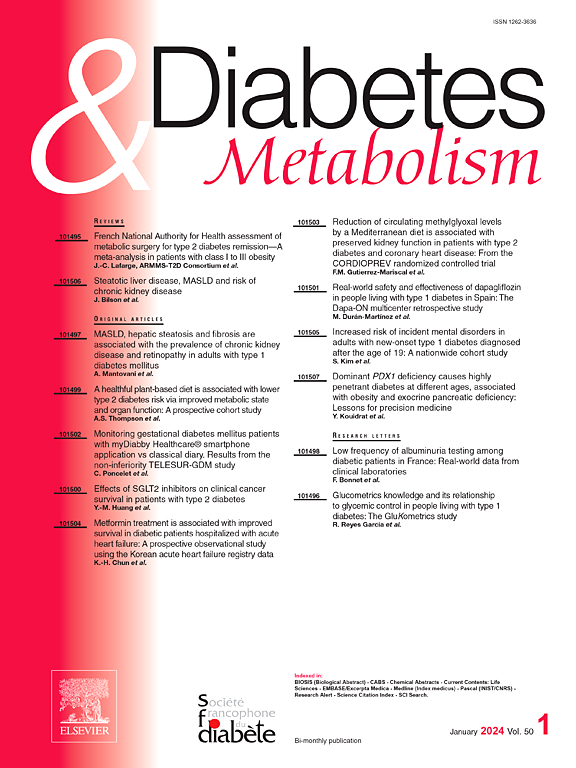在法国奥弗涅,通过监测糖尿病患者在Covid-19禁闭之前、期间和之后的HbA1c水平来分析血糖控制。
IF 4.7
2区 医学
Q1 ENDOCRINOLOGY & METABOLISM
引用次数: 0
摘要
目的:描述糖尿病患者在新冠肺炎禁闭前、期间和之后糖化血红蛋白(HbA1c)监测的血糖控制情况。确定分娩前测量的与分娩期间HbA1c检测相关的因素以及分娩后HbA1c升高1%相关的因素。方法:回顾性、描述性研究18岁以上且在分娩前后至少进行一次HbA1c检测的糖尿病患者。数据从奥弗涅地区(法国)的医学分析实验室收集,包括2019年3月17日至2021年5月11日期间的HbA1c测量数据、年龄、性别、居民区和开处方医生的医学专业。结果:共纳入70286例患者(男性54.1%,平均年龄71.7±13.1岁)。月子前平均HbA1c水平(6.80%±1.16)与月子后平均HbA1c水平(6.80%±1.14)相似。在分娩前HbA1c水平≥9%的患者,分娩后一年HbA1c水平的中位数下降幅度更大,为0.90%。只有24.5%的患者在分娩期间进行了HbA1c检测,其中大多数患者年龄超过80岁,分娩前平均HbA1c水平在7 - 9%之间。对于5.1%的患者,坐月子后平均HbA1c水平增加了一个百分点或更多。年龄小于65岁的患者、分娩前血液检查次数不足的患者以及分娩前HbA1c不平衡的患者在分娩后存在血糖不平衡的风险。结论:坐月子对糖尿病患者HbA1c水平无影响。本文章由计算机程序翻译,如有差异,请以英文原文为准。
Analysis of glycemic control in diabetic patients by monitoring HbA1c levels before, during and after Covid-19 confinement in Auvergne, France
Objectives
To describe glycemic control in diabetic patients monitored by glycated hemoglobin (HbA1c) before, during and after COVID-19 confinement. To identify factors, measured before confinement, associated with HbA1c testing during confinement and those associated with a 1 % increase in HbA1c after confinement.
Method
Retrospective, descriptive study of diabetic patients over 18 years old who underwent at least one HbA1c test before and after confinement. The data were collected from medical analysis laboratories in the Auvergne region (France) and included HbA1c measurements between March 17, 2019, and May 11, 2021, age, sex, residential area, and medical specialty of the prescribing physician.
Results
70,286 patients were included (54.1 % men, mean age 71.7 ± 13.1 years). The average preconfinement HbA1c level (6.80 % ± 1.16) was similar to the average post-confinement HbA1c level (6.80 % ± 1.14). A larger median reduction of 0.90 % points in HbA1c level in the year following confinement was observed in patients whose preconfinement HbA1c level was ≥ 9 %. Only 24.5 % of the patients had an HbA1c test performed during confinement, the majority of whom were over 80 years of age and had an average HbA1c level between 7 and 9 % before confinement. For 5.1 % of the patients, the average HbA1c level increased by one percentage point or more after confinement. Patients ≤ 64, those with an insufficient number of blood tests before confinement and those with an imbalance in HbA1c before confinement were at risk of glycemic imbalance after confinement.
Conclusion
Confinement had no impact on HbA1c levels in diabetic patients.
求助全文
通过发布文献求助,成功后即可免费获取论文全文。
去求助
来源期刊

Diabetes & metabolism
医学-内分泌学与代谢
CiteScore
12.00
自引率
4.20%
发文量
86
审稿时长
13 days
期刊介绍:
A high quality scientific journal with an international readership
Official publication of the SFD, Diabetes & Metabolism, publishes high-quality papers by leading teams, forming a close link between hospital and research units. Diabetes & Metabolism is published in English language and is indexed in all major databases with its impact factor constantly progressing.
Diabetes & Metabolism contains original articles, short reports and comprehensive reviews.
 求助内容:
求助内容: 应助结果提醒方式:
应助结果提醒方式:


